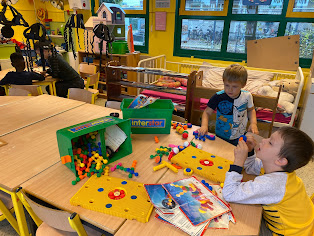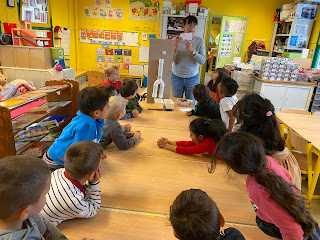For my teaching practice, I go to De Puzzel Basisschool Runkst, which is located in Hasselt. It provides both pre-primary level as well as primary level. The class I observe is the 3rd kindergarten, in which there are 24 students; however, there are only 7 girls. School students in this school are very diverse. In this class, in particular, one mixed pupil is probably of Southeast Asian-Caucasian, two pupils are of African descent, quite a lot are of South and West Asian descent, and the rest are of Caucasian descent.
It is such a big class that the kids are often split into two groups so that other teachers can come and help the classroom teacher by taking the other half of the pupils to a different room and teacher. While most pupils are fluent in Dutch, only a few struggle to catch up with others. Interestingly several of them are able to communicate with me in English really well.
Due to the fact that I have no experience teaching kindergarteners and the language barrier, I am unable to imagine what teaching in pre-primary is like and decide to spend most of my time lending a helping hand to the classroom teacher and the co-teacher whenever they need help. Consequently, by the end of my internship there, instead of just observing, I have taken part in their teaching in countless activities.
However, I also teach the kids one activity called the shadow matching game. Owing to the language barrier, firstly, only two pupils who understand English joined that lesson. Nonetheless, later on, it attracted quite a whole bunch of other pupils who do not speak English too to take part in that lesson. To explain the rules to the students who do not speak English, I rely on my co-teacher to help translate those rules for them.

Before I start observing in this class, I thought that all pupils in the Western world are taught to be brave and independent. In addition, they are allowed to do whatever they want while studying. Besides, they are allowed to speak over their teachers. In reality, only half of my single stories are correct. Instead of focusing on teaching pupils to be brave, teachers here keep emphasizing RESPECT while pupils are learning or doing a project, or discussing a certain topic together. Moreover, when pupils want to say anything or be chosen to do anything, they need to raise their hands. Last but not least, students are often shushed to quiet down when they are making noise too loudly.
When I first step into that classroom, I am mesmerized by the number of materials, tools, and toys that classroom has, and by the fact that there are a lot of corners designated for various plays and learning activities such as a kitchen, bedroom, and main square for lessons, etc. By seeing all the objects stored to be used in that classroom, the cliche I have always heard "learning through play" proves itself really well.
In addition to teaching innately active kindergarteners to learn using the plethora of objects in the classroom in which I get lost without knowing where to go to look for the right object when being asked in my role as a teacher assistant, both the classroom teacher and my co-teacher, always spend their own money buying more and relevant objects to show pupils when teaching them about a certain topic. For instance, my co-teacher goes ACTION to buy some candles and chop them up into smaller pieces in order to teach and show students how candles are molded. The classroom teacher has bought some ingredients to teach the pupils to make apple pies. A common practice I see teachers there so is that most activities they teach students come with actual experiments, which are considered too risky and expensive for Cambodian public education.

What even impresses me more is the presence of a psychologist to come and observe any hyperactive and impulsive pupils in the classroom and come up with suggestions for the classroom teacher to do to deal with those students.
There is no doubt that the healthiness of mental health is inextricably intertwined with the fitness of physical health. That is why the pupils are also made to spend some time at the gym regularly.
Last but not least, as I mentioned earlier regarding "RESPECT", students are asked to create an artwork to give to the teacher sitting in the middle of the pupils to show their gratitude and respect for teachers who have been dedicating their effort, enthusiasm, energy and money to educate pupils to become a holistic citizen who are respectful and value diversity in their society.


















